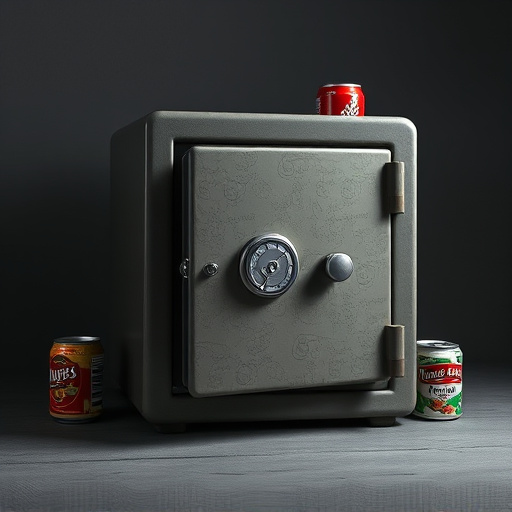In today's digital age, enhancing cybersecurity through concealed security techniques is crucial. Mastering how to disguise a diversion safe within everyday objects like groceries or furniture offers an innovative way to protect personal belongings, intellectual property, and financial records from unauthorized access. By integrating security seamlessly with clever design and materials, individuals and businesses can ensure peace of mind in an interconnected world. Effective strategies include hiding safes in clocks, furniture, or mimicking regular objects like electrical outlets. Key considerations for optimal effectiveness involve blending items with surroundings, securing the safe within packaging, maintaining logs, staying updated on trends, and refining security strategies based on past experiences. Learn how to effectively disguise a diversion safe for enhanced protection.
In today’s world, safeguarding valuable items is paramount. One innovative approach gaining traction is the use of concealed security in consumer product containers, offering a subtle yet effective solution. This article delves into the art of securing your treasures by exploring the importance of hidden safes and providing practical guidance on how to disguise them. From understanding appropriate container choices to creative masking techniques and best practices for implementation, discover the secrets to successfully integrating a diversion safe into your security regimen.
- Understanding Concealed Security and Its Importance
- Identifying Suitable Diversion Safe Containers
- Disguising the Safe: Creative Tactics and Techniques
- Best Practices for Effective Implementation and Maintenance
Understanding Concealed Security and Its Importance
In today’s digital age, where cybersecurity and fraud prevention are paramount, understanding concealed security is more crucial than ever. Concealed security refers to the art and science of integrating safety mechanisms within everyday objects or products, making them appear innocuous while serving as sophisticated defenses against theft, counterfeiting, and unauthorized access. By mastering how to disguise a diversion safe—a secure compartment designed to hide valuable items or sensitive materials—individuals and businesses alike can safeguard their assets effectively.
This tactic involves clever design and innovative materials to create fake consumer product containers that conceal hidden compartments. For instance, a seemingly ordinary box of groceries could secretly hold precious documents or a safe within its walls. Mastering these techniques allows for the protection of personal belongings, intellectual property, and financial records from prying eyes, ensuring peace of mind in an increasingly interconnected world.
Identifying Suitable Diversion Safe Containers
When selecting a diversion safe container, consider materials and design. Metal containers with unusual shapes or those mimicking everyday items like books or fire extinguishers can effectively mask their true purpose. The key is to choose something that blends in seamlessly with its surroundings. For instance, a hollowed-out book or a fake rock with a hidden compartment may go unnoticed while serving as an inconspicuous hiding place for valuables.
Additionally, look for containers with secure locking mechanisms and sturdy builds. A well-crafted diversion safe should be challenging to break into, ensuring your items remain secure. With the right choice, you can create an almost invisible safeguard for your possessions, making it a valuable tool for enhancing home security while maintaining an unassuming exterior.
Disguising the Safe: Creative Tactics and Techniques
Disguising a safe within a consumer product container requires creative thinking and an understanding of tactics that can bypass vigilant eyes. One effective method is to incorporate the safe seamlessly into everyday items that are commonly found in homes or workplaces. For instance, a wall clock with a hidden compartment can be a clever way to conceal valuable items while maintaining a neutral appearance. Similarly, custom-made furniture pieces, such as bookshelves or dressers, can be designed with secret compartments, making them less conspicuous than traditional safes.
Another tactic involves using diversion safes that mimic everyday objects like electrical outlets, light switches, or even fire alarms. These devices are masterfully crafted to look and function like their regular counterparts but secretly harbor valuable contents. Additionally, clever use of false bottom containers in ordinary-looking crates or boxes can provide an extra layer of discretion when packing items for safe storage. How to disguise a diversion safe is not just about aesthetics; it’s an art that leverages everyday objects to create hidden sanctuaries for precious possessions.
Best Practices for Effective Implementation and Maintenance
When implementing a concealed security fake consumer product container, or a diversion safe, it’s crucial to follow best practices for optimal effectiveness. Firstly, choose products that closely resemble everyday items, such as canned goods or juice bottles, to blend in seamlessly with their surroundings. Secondly, ensure the safe is securely attached or hidden within the packaging to prevent accidental discovery.
Regular maintenance is equally vital. This includes periodic checks to verify the integrity of the hiding place and the condition of the products used for concealment. Keep a log of any discrepancies or successful discoveries to refine your strategy over time. Additionally, stay updated with the latest security trends and adapt your methods accordingly to maintain an ever-evolving defense against potential intruders.
Hidden security through disguised diversion safes is a sophisticated method to safeguard valuable items. By understanding the importance of concealed protection, selecting the right container, employing creative disguises, and implementing best practices, individuals can enhance their home or business security. Mastering these techniques allows for peace of mind, knowing that assets are protected from unexpected threats. With the right approach, you can transform everyday objects into secure havens, effectively deterring potential intruders.
